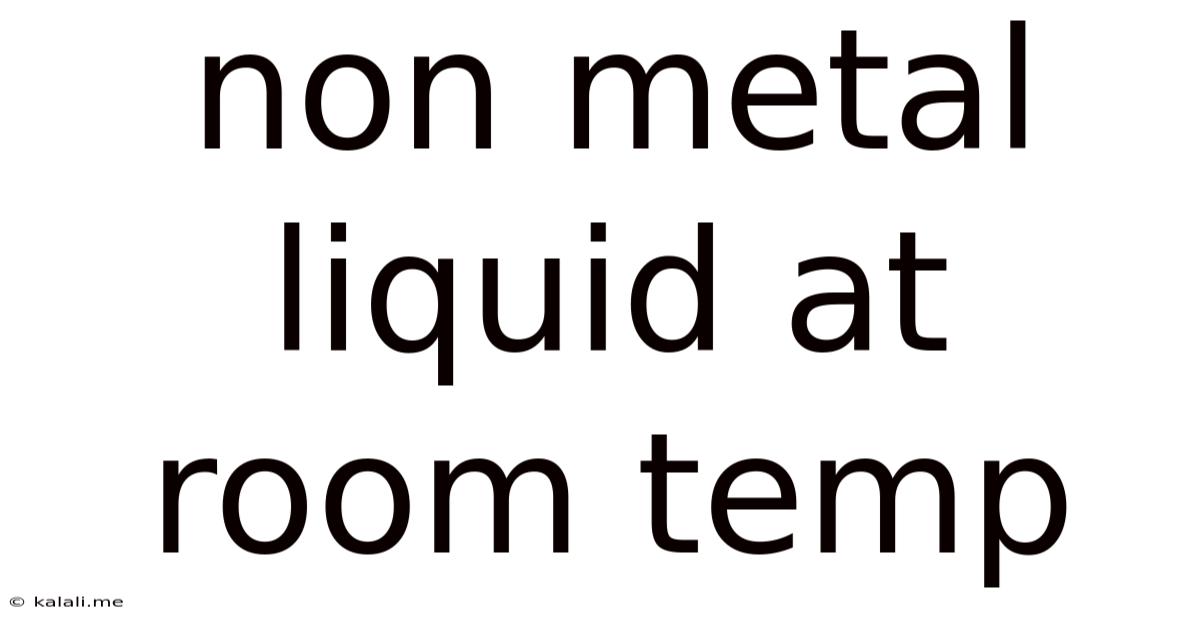Non Metal Liquid At Room Temp
Kalali
Jun 12, 2025 · 3 min read

Table of Contents
The Only Non-Metal Liquid at Room Temperature: Bromine
At room temperature, only one non-metal element exists in a liquid state: bromine. This makes it a unique and fascinating substance worthy of closer examination. Understanding its properties, uses, and safety precautions is crucial for anyone working with or simply learning about this remarkable element.
What makes bromine special? Most non-metals are gases (like oxygen and nitrogen) or solids (like carbon and sulfur) at room temperature. Bromine’s liquid state is due to its relatively weak intermolecular forces compared to other halogens, but strong enough to prevent it from becoming a gas at standard conditions. This unique characteristic sets it apart in the periodic table.
Properties of Bromine
- Appearance: Bromine is a reddish-brown liquid with a distinctive, pungent, and irritating odor. Its vapor is similarly colored and considerably more dangerous due to its highly toxic nature.
- Reactivity: Bromine is a highly reactive element, readily reacting with many metals and other non-metals. This reactivity contributes to its diverse applications.
- Toxicity: Extremely toxic and corrosive. Skin contact should be avoided at all costs, and inhalation of its vapor can cause severe respiratory problems. Working with bromine always requires appropriate safety equipment and procedures.
- Density: Bromine is denser than water, meaning it will sink if mixed with it. This is an important consideration for handling spills and cleanup.
- Boiling Point: Bromine has a relatively low boiling point, meaning it readily evaporates at moderate temperatures. This volatility adds to its potential hazards.
Uses of Bromine
Despite its toxicity, bromine has numerous industrial applications, including:
- Flame Retardants: Brominated flame retardants were once widely used in plastics, textiles, and electronics. However, due to environmental concerns, their usage is declining. Research focuses on finding safer alternatives.
- Water Purification: Bromine compounds are used as disinfectants in water treatment, though chlorine remains the more common choice.
- Agricultural Chemicals: Certain bromine compounds are used in pesticides and fungicides, though their use is also subject to increasing regulatory scrutiny.
- Medical Applications: Some bromine compounds have historical use in medicine, though modern medicine has largely moved towards other alternatives.
- Dye Production: Bromine's reactive nature contributes to its use in the production of various dyes.
Safety Precautions When Handling Bromine
Bromine is extremely dangerous and should only be handled by trained professionals with appropriate safety equipment. This includes:
- Fume Hood: All work with bromine must be conducted within a well-ventilated fume hood to prevent inhalation of its toxic vapors.
- Protective Gear: This includes gloves, eye protection, and respiratory protection. Specialized gloves and protective clothing are essential to prevent skin contact.
- Spill Response Plan: A detailed spill response plan should be in place in case of accidental spills, outlining procedures for cleanup and neutralization.
Alternatives to Bromine in Certain Applications
The search for safer and more environmentally friendly alternatives to bromine in various applications is ongoing. This research focuses on developing substances with similar properties but without the inherent toxicity and environmental concerns associated with bromine.
In conclusion, bromine's unique position as the only non-metal liquid at room temperature makes it a fascinating element, but its inherent dangers emphasize the importance of careful handling and responsible use. Understanding its properties and potential hazards is crucial for anyone interacting with this remarkable substance.
Latest Posts
Latest Posts
-
How Many Cups Are In 16 Oz Of Sour Cream
Jul 01, 2025
-
How Many Quarters Are In 20 Dollars
Jul 01, 2025
-
How Many 1 3 Cups Equal A Cup
Jul 01, 2025
-
How Many Hours Are In Two Years
Jul 01, 2025
-
Did You Hear About The Antelope Who Was Getting Dressed
Jul 01, 2025
Related Post
Thank you for visiting our website which covers about Non Metal Liquid At Room Temp . We hope the information provided has been useful to you. Feel free to contact us if you have any questions or need further assistance. See you next time and don't miss to bookmark.